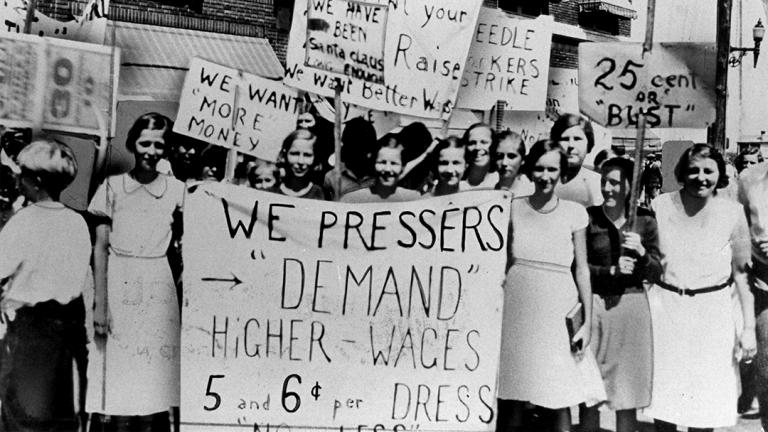The history of the Australian working woman is long, complex and packed with stories of tenacity and triumph, inequality and injustice. Looking back at the struggles and victories of the women who came before us, we gain an appreciation for what we have today, and a renewed perspective of what we need tomorrow.
Beginnings
The history of work for both white and Aboriginal women in Australia begins with forced labour, but while white women were sent to Australia to carry out this work as punishment for crime, Aboriginal women were innocent, and removed from their families and homes through no wrongdoing of their own.
In 1788, 192 women were transported to Australia, as convicts on the first fleet. Throughout the period of convict transportation, women were housed in “female factories” carrying out task work while waiting for a permanent assignment. These female factories were correctional facilities that housed convict women who were either waiting to be sent out to work or who were being held to be punished for behaviour while on assignment.
Pregnant convict women were also sent to female factories and, later, free settler and ex-convict women were sent to female factories to serve out punitive sentences for crimes they had committed. Women carried out work necessary to run the female factories, such as washing and cooking, as well as other work necessary within the wider colony, such as sewing, carding wool and working as hospital attendants. The type of work carried out was dependant on the “Class” of the women, which was determined by their reason for incarceration and their behaviour while in the facility.
Once freed, convict women faced limited work prospects, due in large part to the scarcity of work and the difficulties associated with setting up their own business. Many instead married. Men had far better work and earning prospects, and for some women, marriage represented the only guarantee of long-term financial stability and housing security.
Many freed convict women found themselves with a choice between domestic labour or sex work. Domestic labour was incredibly physically demanding, and often carried out in harsh conditions. For many, payment for accommodation, food and clothing was difficult, and there was often pressure to exchange sexual services for these necessities. It is a common misconception that prostitution was a transportable offence. It wasn’t, and many women who engaged in this work did so for the first time within Australian colonies.
The first white working women in Australia faced poor pay, harsh conditions and a choice of vocation so limited it was virtually non-existent. The first industrial action carried out by Australian women was the 1872 Parramatta female factory riot, when women housed in the facility rioted over cut rations, and the poor conditions and treatment they faced.
The working history of many Aboriginal women begins with forced labour, stolen wages and mistreatment at the hands of the families they worked for. As traditional Aboriginal social, economic and political ways of life were dismantled by white settlers, Aboriginal women and girls as young as 12 were removed from their families by force, taken to missions and reserves run by the government, and trained to work as domestic labourers for white families.
While living with the families they worked for, women sometimes denied basic necessities, such as adequate shelter, and faced violence at the hands of their employers. Many young women were persistent in reporting this abuse to government authorities, with varying success in being re-assigned to another family.
Wages that many of these women earned were redirected to the government to be held in trust. A small percentage of their wage was ostensibly paid as pocket money to these women, but in reality, their employers often pocketed this sum, leaving many Aboriginal women completely unpaid. Most of the wages held in trust by the government were also never paid.
In some areas, this exploitation continued through until the 1970’s, with Aboriginal women (and men) today still fighting to recover a lifetime of lost wages. Women such as Pearl Gibbs worked tirelessly to improve the conditions of their fellow Aboriginal women, organising strikes and calling for citizenship rights and improved working conditions.
In 1882, the first female trade union, The Tailoresses’ Association of Melbourne, was established, and in 1890 the Working Women’s Trade Union was formed in South Australia. Women’s involvement in labour movements during this time was limited, but critical in working to improve the conditions of the Australian working woman.
During World War II, many women took up jobs normally reserved for men, such as management positions, factory work, and work on military bases. The shortage of working men forced the hand of many businesses, and they began hiring women out of necessity. Once the war ended, and men began to return, the reaction of the women in their roles were mixed. Some women were relieved to no longer have to balance demanding work, volunteer and family roles, while others were less than happy to relinquish their positions.
It was not uncommon that a woman had been performing highly, and found it unfair that men could return and reclaim the job. Many women enjoyed the increased responsibilities and duties that jobs in factories, banks, military and management roles gave them. After the war, the return to “women’s work” was a bitter pill to swallow for some, and this is often credited as a turning point for the advancement of working women in Australia. Having kept the nation running through the war, women weren’t satisfied seeing their contributions forgotten or undervalued.
In 1912, minimum wage for women was set at 54% of men’s minimum wage. Lower wages for women at this time were largely based off the idea that women’s wages only needed to provide for herself, as the breadwinner of any household would be a man, and he should therefore earn a wage to support an entire family. This was criticised as a deliberate attempt to keep women out of paid work. A federal case in 1969 introduced the concept of equal pay for equal work, and unions fought to have the difference in male and female minimum wages eliminated.
In practice, this principle didn’t provide a pay raise for most women. It only granted equal pay to women doing the exact same work as men. As only around 18% of working women were doing jobs also carried out by men, most women saw no benefit from this ruling.
A 1972 review extended the principle to “equal pay for work of equal value”. This meant that work of similar value to men’s’ work made women eligible for equal pay. In theory. In reality, women in many industries and jobs struggled to have their work fairly assessed, and jobs considered to be “female roles” remained deeply undervalued. In 2010, women earned 82% of the average male wage.
Today’s Working Woman
In March 2023, the ABS announced that women’s participation in Australia’s labour force was at an all-time high of 62.5%, with Australia’s overall participation rate sitting at 66.7%. This statistic reflects the percentage of the population of working age (over 15), who are either in paid employment, or actively job seeking. Currently, 47.4% of Australian workers are women.
The rise of women’s workforce participation rates have been slow, and influenced by a variety of factors. Paid maternity leave and an increased availability of child care have both been shown to positively impact women’s workforce participation rates. A number of less obvious factors have contributed as well. The introduction of the pill in the 1960s caused a rise in workforce participation, as women had more control over family planning than they had before. The current high percentage of women’s workforce participation is at least somewhat due to the gradual decrease in men’s participation, as many Australian men retire from the workforce.
Women make up a disproportionately large percentage of Australia’s part-time workers and casual workers, being 68.5 per cent.
The Workplace Gender Equality Agency (WGEA) February 2023 pay gap statistics were show a 13.3% full-time gender pay gap. This means that, on average, full-time employed Australian women earn $253.50 less per week than full-time employed Australian men.
The WGEA identifies several contributing factors to this pay gap:
- Discrimination and bias in hiring and pay processes
- Different industries and jobs being either male or female dominated, with many female dominated jobs and industries paying lower wages
- The disproportionate share of caring and domestic work carried out by women
- A lack of flexibility in workplaces when it comes to accommodating outside responsibilities
- Women taking more time out from the workforce, impacting career progression and other opportunities
Analysing and contextualising pay gap and workforce participation statistics can be tricky, and the factors at play are numerous and varied.
For example, the statistic that women, on average, retire four years later than men could be seen as a positive indicator of women’s engagement in Australia’s workforce. Couple this with the statistic that Australian women, on average, have 42% less superannuation than Australian men, and we might find ourselves asking if this extra four years of workforce participation is a choice, or a necessity.
The WGEA’s 2023 statistics on women in leadership show that women hold only 18% of chair positions and 33% of directorships. Only 19.4% of Australian CEO’s are women.
What do we need to consider moving forward?
This year’s International Women’s Day theme is #PressforProgress, urging us to keep working towards creating a fair and just society, however difficult it may be. While we reflect on how far we have come, it is important that we don’t lose sight of how far we have to go. The following are just a few of the many important questions to consider moving forward.
Is there an inherent difference in the way men and women need their working lives structured?
In many instances, it could be argued that there are greater societal forces at work. Many women choose to be stay at home parents for all or part of their working lives, but far fewer men choose to do the same. Caring for ageing parents is cited as a consideration for many women when it comes to working arrangements, but fewer men do the same. When we look at the flexible work arrangements offered to working mothers, should we be more actively encouraging men to take these up as well? Or instead?
Why are some jobs still seen as “women’s work” and others not?
Only 12% of all trade apprentices in Australia are women, with most being hairdressing apprentices. How can we fairly and sustainably encourage more women to enter roles that are traditionally dominated by men? Currently, female mining engineer graduates are receiving a starting salary 15% higher than those of male graduates. Is this sort of incentive the right way forward, or is there more that needs to be done? In professions traditionally female-dominated, such as education and healthcare, the majority of CEOs, Chairs and Directors are still men. How do we best address this imbalance?
Should we be talking (and listening) to each other more?
How often do we discuss the issues surrounding gender parity with the people around us? It is important to remember how nuanced and varied the experiences of women are, and to value the experiences of individuals. For many women, their experience in the workplace is informed not only by gender, but by other aspects of their identity, such race, disability and sexual orientation.
It’s imperative that we listen to the women around us, and actively seek out the points of view of women who may be marginalised in ways that we are not. A respectful, consistent and constructive dialog around the experiences of all women in the workplace is invaluable when it comes to moving forward.
How can individual men help?
One way that is often suggested for men to help is to tell a female co-worker how much money he makes. The reasoning behind this is that a culture of not-quite-secrecy but certainly reticence around our salaries makes it that much easier for organisations to avoid addressing gender pay gaps. Not all may feel that this is appropriate, but it is not uncommon for a female employee not to even realise that her male peers are being paid more than her.
Could it be argued that more men should volunteer to be stay at home Dads, or work part-time to help with child care? Questioning the long-upheld social norms that we sometimes think of as “just the way things are” is an important aspect of any individual’s contribution to social change.
Looking back at the history of Australia’s working woman, we see that that change has really been the only constant. Women have proven to be adaptable and flexible, and for too long have faced environmental factors that have negatively impacted their ability to participate in Australia’s workforce.
As jobs become less permanent and more contract, as roles become less structured and more diffuse, and as work itself becomes less certain and more flexible, women’s history of adaptability and resilience will serve them well in the workplace.
If we can sustain a focus on gender parity in the workplace, and continue to do all that we can to #PressforProgress, we can ensure that the future of Australia’s working woman is a bright one.










